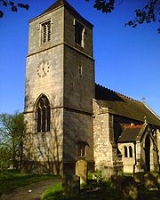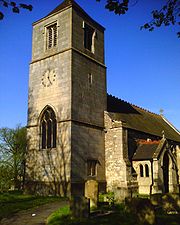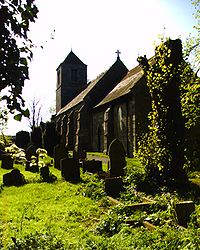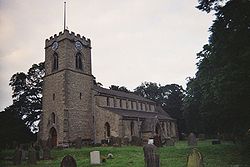
Hybald
Encyclopedia

Anglo-Saxons
Anglo-Saxon is a term used by historians to designate the Germanic tribes who invaded and settled the south and east of Great Britain beginning in the early 5th century AD, and the period from their creation of the English nation to the Norman conquest. The Anglo-Saxon Era denotes the period of...
saint
Saint
A saint is a holy person. In various religions, saints are people who are believed to have exceptional holiness.In Christian usage, "saint" refers to any believer who is "in Christ", and in whom Christ dwells, whether in heaven or in earth...
, who died circa 690.
The Venerable Bede tells of a St. Hygbald who was a Benedictine
Benedictine
Benedictine refers to the spirituality and consecrated life in accordance with the Rule of St Benedict, written by Benedict of Nursia in the sixth century for the cenobitic communities he founded in central Italy. The most notable of these is Monte Cassino, the first monastery founded by Benedict...
abbot in the old Kingdom of Lindsey
Kingdom of Lindsey
Lindsey or Linnuis is the name of a petty Anglo-Saxon kingdom, absorbed into Northumbria in the 7th century.It lay between the Humber and the Wash, forming its inland boundaries from the course of the Witham and Trent rivers , and the Foss Dyke between...
and it is believed to be buried in the village of Hibaldstow
Hibaldstow
Hibaldstow is a village and civil parish on the B1206, south of Brigg and the M180, in North Lincolnshire, England. The deserted medieval village of Gainsthorpe is situated nearby.-History:...
, whose name means holy place where St Hygbald is buried. The Venerable Bede in his Ecclesiastical History describes St Hybald as a "most holy and continent man who was an abbot in Lindsey" (now Lincolnshire) and a friend of Saint Chadd, he followed his living example and became an hermit
Hermit
A hermit is a person who lives, to some degree, in seclusion from society.In Christianity, the term was originally applied to a Christian who lives the eremitic life out of a religious conviction, namely the Desert Theology of the Old Testament .In the...
. After his death and canonisation, a shrine was built to hold his relics and became a place of pilgrimage. This continued till Protestants after the Reformation
English Reformation
The English Reformation was the series of events in 16th-century England by which the Church of England broke away from the authority of the Pope and the Roman Catholic Church....
destroyed the shrine, but not his body, continued to lie under the church in Hibaldstow until it was rediscovered in 1866 when the then dilapidated temple was rebuilt.


Parish church
A parish church , in Christianity, is the church which acts as the religious centre of a parish, the basic administrative unit of episcopal churches....
es of Hibaldstow and nearby Scawby
Scawby
Scawby is a village and civil parish in North Lincolnshire, England. According to the 2001 census it had a population of 2,277. It is located south west of Brigg just off the A15 and A18. Scawby Brook, just outside Brigg, is also within the parish....
and, further away, Ashby de la Launde
Ashby De La Launde
Ashby de la Launde is a small village, part of the civil parish of Ashby de la Launde and Bloxholm, in the North Kesteven district of Lincolnshire, England.The villages is located just west of Digby, and east of the A15 and B1191 roads...
, are all called St. Hybald's.
His Namesdays are 18 September (RC) and 14 December (Orthodox).

